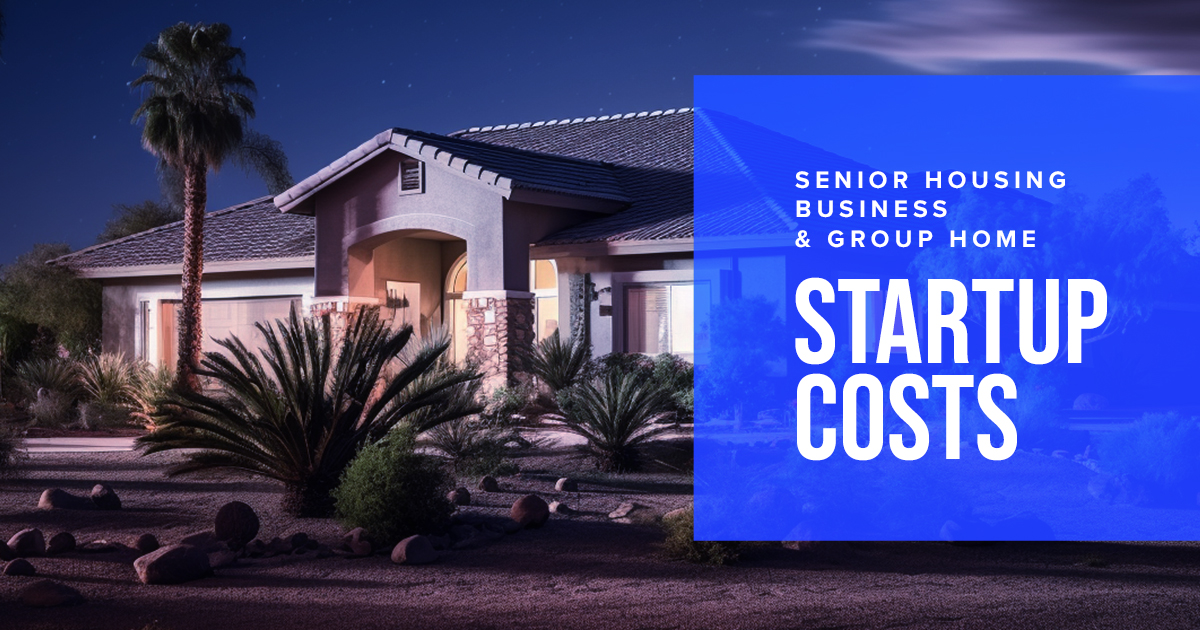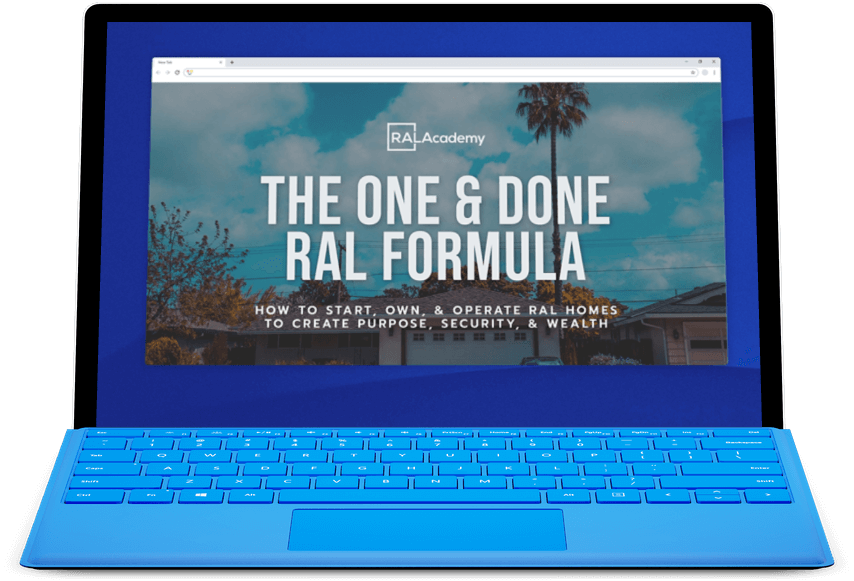How much does it cost to start a group home or a senior housing business? Most adult children think about senior living within the scope of, “Should I house my parent or should I find a home for my parents to live in?” but the question of, “How much does it cost to start my own senior housing business?” is viable and, quite frankly, the best solution for many.
The aging population in the United States is creating a critical shortage of assisted living facilities. The number of seniors is rapidly increasing, and this group’s impact on society is undeniable.
Seniors, Boomers in particular, are a growing demographic, and their needs must be met.
The number of seniors in the United States is expected to double by 2060. With Baby Boomers outnumbering young adults, there will soon be an overwhelming shortage of quality assisted living facilities in the United States if nothing is done to address it.
This great need presents an incredible opportunity for investors and entrepreneurs of all experience levels to break into the senior housing business. Whether you are a seasoned investor with 100 real estate properties or a brand new entrepreneur, starting an assisted living business is one of the best decisions you could make if you are looking for a real estate deal that produces significant monthly recurring cash flow.
Savvy investors and business professionals are flocking to assisted living due to:
- High demand
- High profit margins
- Demand for this service doesn’t diminish with market fluctuations
Starting an assisted living facility can be a challenging but rewarding experience. If you are willing to put in the effort, you can create a successful senior living business that meets massive market demand.
If you are curious about any of the following:
- How to invest in senior housing
- Senior housing business opportunities
- How to start a senior home care business
- The cost of running an assisted living facility
- The amount of money you can make investing in senior housing
Then this article is a great place to start to find the answers.
The key to this industry is gaining the experience and tools to become successful.
You don’t need to have all the answers, but you need to know where to go to find them. Even if you have no prior experience and limited funding with the right training and support, you can find financial freedom in owning a successful residential assisted living business.
How Much Does it Cost to Start a Senior Housing Business?
The cost of starting a group home senior housing business varies depending on the size of the home, the location, and the level of care provided. There are many choices for seniors these days; some of the most popular models of senior housing include:
- Independent Living
- Shared Senior Housing
- Retirement Communities
- Traditional Assisted Living
- Skilled Nursing Homes
- Residential Care Homes
- Memory Care
For the purpose of this article, we will be speaking primarily about the residential care home, or RAL home, and the memory care home.

While it is difficult to put a specific number on assisted living startup costs, as there are so many unique variables involved (the size of the home, the location of your property, and other licensing or permitting processes), here are some of the primary costs you will need to factor in:
- Property: The cost of purchasing or renting a property will be one of your biggest expenses. You must find a property large enough to accommodate the number of residents you plan to serve in a safe and convenient location. Some prefer to buy the land and build a specialty RAL home on it rather than buying a large single-family home and retrofitting it to accommodate the needs of senior residents. Either way, the main cost to build an assisted living facility is found with this initial purchase and is dependent on location, size, local RE market, financing, seller’s motivation, etc.
- Permits and licenses: Obtaining the required permits and licenses from your state and local government is crucial. These requirements can vary from state to state, so do your research early on.
- Staffing: Hiring staff to provide care for your residents is crucial. It includes care staff, managers, aides, cooks, and housekeepers. The cost of staffing will vary depending on the level of care required.
- Furniture and equipment: Furnishing your home with beds, dressers, tables, chairs, and other essentials is necessary. You may also need to purchase specialized equipment, such as wheelchairs or walkers, for residents with disabilities.
- Marketing and advertising: Marketing your home to potential residents and their families is essential. It involves advertising in local newspapers and magazines or creating a website and social media presence.
In addition to these costs, you need to factor in the cost of day-to-day operations, such as food, utilities, and insurance. The cost of these expenses will vary depending on the size of your home and the number of residents you serve.
Starting a group home senior housing business is a big undertaking but it is incredibly rewarding. You need to do the research before jumping into a project like this and reach out to the experts when you have questions or concerns about your investment plans.
Want to see how the numbers flesh out? Get access to the free RAL Profitability Calculator and get an idea of how much profit you could earn with your own RAL home.
How Does Senior Housing Work?
Senior housing is a broad term that encompasses a variety of housing options for seniors. These options range from independent living apartments to assisted living facilities to nursing homes.
Independent Living is a type of senior housing that provides residents with their own apartments or homes. Independent living communities typically offer amenities such as meals, transportation, and social activities but do not provide assistance with activities of daily living (ADLs) such as bathing, dressing, and grooming. Residents are typically able to live independently and manage their own care.
Assisted Living is a type of senior housing that provides residents with a higher level of care than independent living. Assisted living communities typically offer 24-hour staffing and assistance with ADLs, transportation, and other tasks. They may also offer additional services such as medication management and memory care. Memory care communities are part of the assisted living model and are designed for seniors with Alzheimer’s disease or other forms of dementia. These communities provide a safe and supportive environment with specialized care and services.
Nursing Homes are a type of senior housing that provides the most intensive level of care. Nursing homes typically have medical staff on-site and can provide skilled nursing care, such as wound care and IV therapy. They may also offer rehabilitation services, such as physical therapy and occupational therapy. These facilities are usually larger and have between 50-100 residents, with large numbers of staff, and equally large financial overhead. When people see senior housing in the news or movies, this is usually the type that is involved.
Residential Assisted Living (RAL) is a unique type of senior housing that offers traditional assisted living services in a residential setting. These businesses usually operate in single-family homes designed to accommodate between 6-12 elderly residents. Residential assisted living communities typically offer residents their own space in a comfortable and cozy environment as well as 24-hour staffing and assistance with ADLs. They also usually provide additional services such as medication management and other boutique amenities that cater to small groups of seniors. Many offer specialty services like memory care.
Residential assisted living is unique in that it delivers a higher level of comfort and privacy than traditional or big-box assisted living while still providing access to 24-hour care and assistance.
It not only makes it a good option for seniors who need some assistance with ADLs, but it is also the type of accommodations that seniors prefer. The smaller number of staff and residents in RAL homes allows for more personalized care. Socialization is also more personalized, as seniors don’t have to deal with the constant turnover rate of residents and staff like in the large nursing-home-style facilities.

The Senior Housing Business Model
There are many different business models for senior housing. It starts with the type of senior housing the investor pursues, i.e., independent living, assisted living, memory care, skilled nursing, etc.
The cost of senior housing varies depending on the type of community, the level of care provided, and the location. For example, independent living communities typically cost less than assisted living communities, which cost less than memory care communities. Skilled nursing facilities are the most expensive type of senior housing.
Senior housing providers can generate revenue through a few methods. Residential fees are monthly payments that residents or their families make to live in a senior housing community. This fee usually covers the cost of rent, utilities, meals, amenities, etc. Some senior housing businesses offer all-in-one structures, while others, often the large corporate-backed facilities, initiate a host of additional costs and fees.
- Medicare and Medicaid: Medicare and Medicaid are government programs that provide financial assistance to seniors who need long-term care. Senior housing providers may be able to participate in these programs to receive reimbursement for some of the care they provide. Basing your business on this form of payment generally doesn’t provide the profitability that most senior housing investors are looking for.
- Private pay: Many seniors and their families choose to pay for their senior housing out of pocket. It is often the case for seniors who have private long-term care insurance or who have the financial resources. It is the method that experts at the RAL Academy encourage investors to pursue when building their RAL business. While it doesn’t include all seniors, there are plenty of seniors who have the means to pay for high-quality services and amenities.
The senior housing industry is growing, and there is a high demand for quality senior housing options. Your future success starts with the right plan. A good senior housing business model is sustainable and profitable. It should also meet the needs of the aging population in your community. Here are some of the key elements involved in a good senior housing business model:
- Location: The location of the senior housing facility is important. It should be located in a community that is convenient for residents and their families. It should also be in a safe and accessible neighborhood, close to amenities such as shopping, restaurants, and healthcare facilities.
- Services: Senior housing facilities provide many services to meet the needs of residents. The specific services your business offers is dependent on your goals. Senior housing facilities generally furnish a combination of the following:
- Housing
- Meals
- Laundry
- Transportation
- Activities
- Personal Care
- Medical Care
- Staff: Senior housing facilities should have qualified staff that is trained to provide care for the elderly. They should be compassionate, understanding, and able to create a warm and welcoming environment for residents and their families.
- Pricing: The pricing for senior housing can vary depending on the type of facility, the location, and the services offered. It is important to set prices that meet the financial abilities of the families where the facility is located.
By understanding these key elements for your specific market, you can create a successful senior housing business that thrives for years to come while meeting the needs of the aging population.
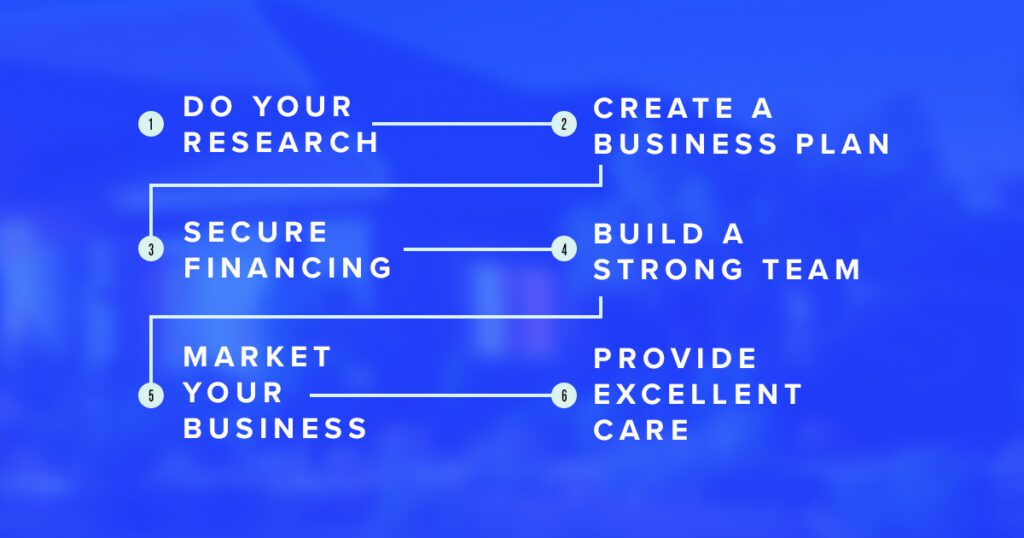
Here are some additional tips for creating a successful senior housing business model:
- Do your research: Before you start a senior housing business, it is important to research and understand the industry. It includes understanding the demand for senior housing, the cost of operating a senior housing facility, and the regulations that govern the industry.
- Create a business plan: A business plan is a roadmap for your business. It should include your goals, strategies, and how you plan to achieve them.
- Secure financing: Starting a senior housing business can be expensive. You need to secure financing to cover the costs of construction, marketing, and operations.
- Build a strong team: A successful senior housing business requires a strong team. You need to hire qualified staff and build relationships with other professionals in the industry.
- Market your business: Once your senior housing facility is open, you must market your business to potential residents and their families. It includes advertising, public relations, and word-of-mouth marketing.
- Provide excellent care: The most important factor in the success of your senior housing business is providing excellent care to your residents. It includes providing quality medical care, nutritious meals, and a safe and comfortable environment.
Employing a comprehensive and proven model for business is the best way to ensure that your senior housing business is a thriving success. If you have questions about the right strategies to help you meet your goals, you won’t find a better resource than the RAL Academy. We are all about helping RAL owners provide quality care to seniors while generating substantial cash flow.
If you want to dive deeper into the business model and have the next steps identified for you, we have a free Intro Course for Residential Assisted Living that serves up that information clearly.
Developing A Senior Housing Business Plan
Once you have decided that you want to pursue an assisted living business it’s time to come up with an assisted living business plan. Do your research and seek guidance from experts and those who have already found success in the industry.
5 P’s of A Successful Senior Housing Business Plan
A successful business plan can be broken down into five sections:
- People
- Product
- Position
- Projections
- Plan for your exit
People
Identify the people directly involved with the business. Investors will want to know about the people involved in your business. Who are you, who is on your team, and who else will be operating within your senior housing business? They’ll ask, “What experience do they have in this industry?” or “What have they done that’s similar to this industry?”
Product
Spell out what your service is. It is your chance to show that you know what you’re doing and you have a plan for your brand. What will you offer? What makes your product unique?
Position
Where do you fit in the market? What are your strengths and weaknesses? What are the opportunities and threats in the market? You want to avoid the extremes of the market. On the high end, few customers are very demanding. On the low end, there is a lot of competition; you have to lower your prices to compete. Your goal is to be in the sweet spot, somewhere just above the middle.
Projections
What are your financial projections? How much money do you need to start your business? How much money do you expect to make in the first year? Create financial projections that show how your business will make money, how much revenue you expect to generate, and what your expenses are.
Plan for your exit
How do you plan to get out of the business? Will you sell it? What are your exit goals?
In the residential assisted living industry, it is especially important to have a strong team of people involved in the business. Investors want to see that you have experience in the industry or that you have surrounded yourself with people who do. Your team should be able to offer complementary skills and experience, and they should be able to help you achieve your goals.
Here are some additional tips for establishing a successful senior housing business plan:
- Do your research. Make sure you understand the market and the competition.
- Be realistic. Don’t over-promise and under-deliver.
- Get feedback. Ask for feedback from experts and potential investors.
- Revise and edit. Make sure your business plan is clear, concise, and error-free.
By following these tips, you can write a successful business plan to help you create relationships with the right lenders and partners, leading to a greater chance of success.
If you want to learn more about the specifics of developing your business plan for assisted living, check out our article, Residential Assisted Living Business Plan, where we do a deeper dive into the details.
Myths and Misconceptions of Assisted Living
The first thing people usually say when they hear about the incredible financial opportunity of investing in residential assisted living is, “I don’t want to take care of old people.”
We get it.
Not everyone is made to care for the elderly, and not everyone has the heart or understanding to do that job well. But the great thing about the RAL model of investing is you don’t have to be the one that “takes care of old people.”
As an investor, entrepreneur, or business person, you need to set up the business and take care of the logistics, then hire people with the heart and compassion to care for seniors. Many people find their passion and purpose in caring for the elderly. If you incorporate them into your team, it will be an incredible thing.
Many RAL Academy students have used the RAL model to build thriving businesses encompassing many RAL facility locations, and some are doing this hands-off, even from another state. Others prefer to be hands-on and involved in the day-to-day workings of the business. Your involvement is up to you. It’s all about having the know-how to do it correctly and efficiently, building the infrastructure, establishing the systems and procedures, and assembling the right team.
When looking at the various ways to begin in assisted living, the most profitable ways to invest are:
- Real Estate Owner: You can own the assisted living property and lease it to a reputable operator. It allows you to earn higher than market rent with a long-term tenant. The higher cash flow will allow you to buy better properties in nicer areas that are likely to appreciate faster than average rental homes.
- RAL Business Owner and Operator: You can own the home and operate the assisted living business or manage your team to do it. This option requires more investment of time and money but can be very rewarding. With the right team and strategy, you will achieve a high net income from a single-family home.
- Private Lender or Joint Venture Investor: You can provide financing to an assisted living business. This option can be profitable, but it is important to do your due diligence and understand the risks involved.
The best way to invest in assisted living depends on your individual circumstances and goals. If a challenging and rewarding opportunity is what you are looking for, starting from scratch may be the best option. If you are looking for a less risky option, buying an existing business is a better choice. And if you are looking for the most passive investment, being a hands-off investor is the best option.
Here are some additional things to consider when starting in assisted living:
- Research: Before you invest in an assisted living business, it is important to research and understand the industry. It includes understanding the demand for assisted living services, the regulatory environment, and the competitive landscape.
- Reputation: If you are not interested in operating the business, work with a reputable operator. A reputable operator will have a proven track record of success and will be able to provide you with the necessary support.
- Risks: Investing in assisted living is not without risk. The industry is highly regulated, and the demand for services can be volatile. It is important to understand the risks involved before you invest.
By following these tips, you can increase your chances of success when investing in assisted living.
The Financial Opportunity in Senior Housing
When we ask our students how much money they need to earn each month to live comfortably, most answer around $10,000.
Let’s say you have $10,000 in net cash flow each month. Would you feel you had enough money to live the way you want?
In the residential assisted living business model, the truth is that $10,000 is just the beginning.
You can earn much more than that with a residential assisted living home. The rents you can receive are dependent on several factors.
Many factors determine exactly what kind of profit is possible for each business.
Occupancy is key.
The majority of residents in residential assisted living facilities are seniors that have income from retirement, savings, and trusts. These residents will pay monthly rent plus any additional fees for extra care.
One of the most fundamental decisions you will make when opening your own RAL business is deciding how many residents you will have in your home. This foundational choice is a big part of what we cover in our formal assisted living business education.
As you seek to maximize the income possible in a senior housing business, there are a few elements that stand out.
- Locate the business in a high-demand area
- Offer a range of services
- Provide high-quality care
- Market effectively
Locate the business in a high-demand area
Senior housing is in high demand, so it is important to locate the business in an area where there is a large population of seniors. You are not marketing directly to seniors but to their families. You want to focus on areas where the families of seniors live, specifically families with financial means.
Senior housing businesses in high-value areas like major cities in upscale neighborhoods can charge much higher rates than businesses in rural areas.
Offer a range of services
Senior housing businesses that offer a wide range of services set themselves apart from the competition and can charge higher rates than businesses that offer only basic services.
Provide high-quality care
Senior housing residents look for a safe and comfortable place to live, so it is critical to provide the highest quality of care.
Market effectively
Senior housing businesses need to market their services to attract residents. It is done through social media, traditional advertising, public relations, and direct mail.
The profit margin for a residential assisted living facility can vary depending on unit size, exclusivity, location, and the level of amenities and care provided. It’s important to do a full-scale market analysis to understand the needs of your target market and how much you can charge for your services.
So how much does a senior housing business make? That’s up to the owner and/or investor. There are strategies to make it extremely profitable, but there are also ways to be sure you are breaking even. We want investors and RAL owners to make the kind of money that gives them financial freedom while providing superior care to our nation’s seniors.
As we have found with so many of RAL Academy’s students whose businesses are successful, they feel an even stronger pull toward building and growing their RAL, leading to more RAL facilities opening up across the country. And with the demographic projections surrounding Baby Boomers and the massive need they will soon have for these types of senior care homes, the more facilities run by competent and mindful owners, the better for our seniors.
Our goal is to help more people successfully invest in this industry because there is a Silver Tsunami of seniors coming to these shores; if America isn’t ready to meet this demand, the results could be disastrous. We are doing our part. Why not join us on this incredible journey?
If you want more specifics about senior care home business profitability, we have designed a tool to help investors and business owners get a comprehensive look at what you can expect with our RAL Profitability Calculator.
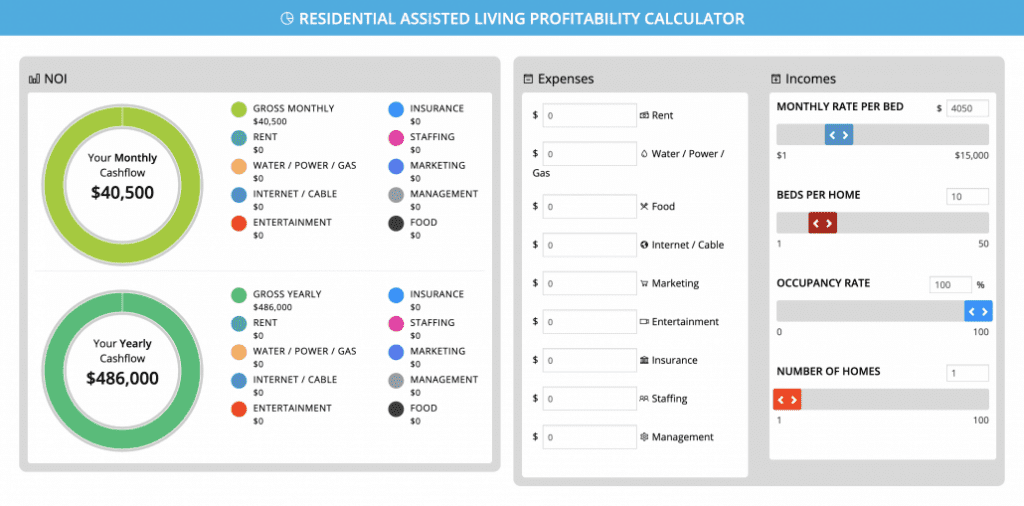
If you want to run a successful business that generates a significant income, there are some factors you need to consider. The Profitability Calculator helps answer these questions and gives more clarity about your income potential in the residential assisted living industry.
The Profitability Calculator is a valuable tool for anyone considering a career in residential assisted living. By using the calculator, you gain a better understanding of the income potential in this industry and make informed decisions about your business.
Maximum Income for a Senior Housing Business
The financial opportunity for those who start an assisted living business is substantial, and a large reason why so many entrepreneurs are getting into this industry. The cash flow alone is enough to make most people think about switching careers.
But what is the maximum income someone can make from this business model? How much does senior housing cost?
Consider the average cost for a private room in an assisted living facility is over $5,350per month.
Multiply that by the number of beds in the facility, say 10, and your income is $43,000 per month minus expenses.
Typical expenses for these businesses are things like a mortgage on the property, staff wages, insurance, food, supplies, etc.
When all is taken into account, students who follow the RAL Academy’s unique investment model can generally make around $10k per month net profit.
Once one RAL home is up and running, the profit can be used to start another. Once the second is profitable, it can be used to start another, and so on.
Unlike some business ventures, there is no maximum income for senior housing businesses because this model is extremely scalable. In fact, we encourage investors to plan on establishing 3 separate RAL homes within the same city. The demand is so high for this business that you will not be competing with yourself. However, the benefits of having multiple RAL homes are immense, such as sharing staff, resources, independent contractors, and purchasing supplies in bulk, just to name a few.
Then consider the profitability.
If one single-family home can net you $10K per month, then three properties would net $30K.
There aren’t many businesses out there that offer that kind of financial return to novice investors. And definitely not in fields that allow you to do so much good in your community at the same time. This business is experiencing growth because it is unlike any other business or real estate play out there.
The scalability of this business is virtually limitless, and many successful RAL Academy students have 6 or 7 RAL homes with plans to expand even more.
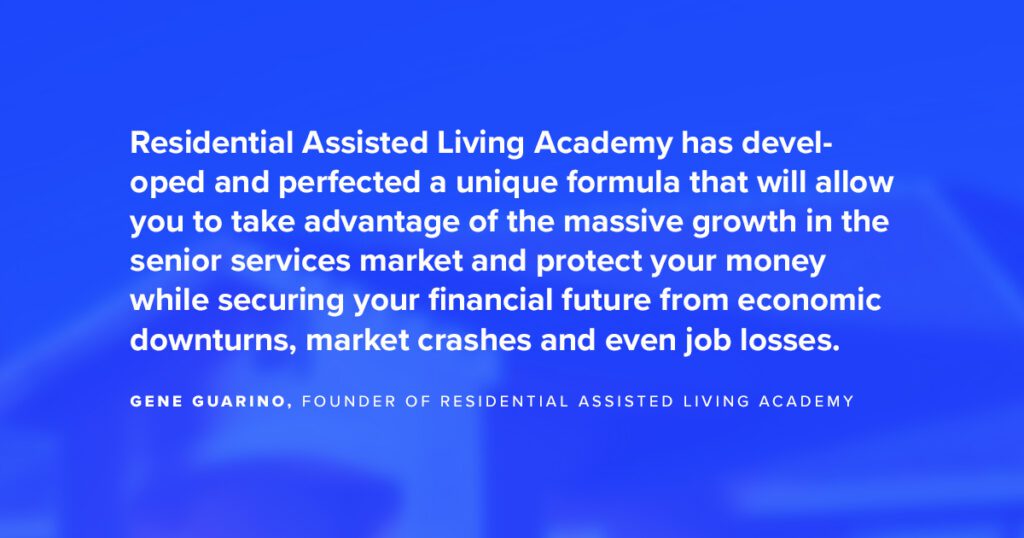
The senior housing industry is expected to grow significantly in the coming years as the population ages. If you are considering starting a senior housing business, it is important to do your research and seek advice from the best sources in the industry.
Startup Costs for an Assisted Living Business
Residential assisted living businesses can be incredibly rewarding not only financially but also in terms of personal fulfillment and support to the community. So how much does it cost to start a group home senior housing business? That depends on many different factors; there is no one-size fits all approach.
It is important to note that not all homeowners will have the same startup costs.
The cost of starting a residential assisted living home will vary depending on many factors, including the size, the location, and the level of care provided.
Here are some of the major startup costs you’ll need to consider:
Real Estate and Construction
If you’re building a new assisted living facility, you’ll need to purchase land zoned for residential use and construct the building. You must hire an architect to design the RAL home and building contractors to build it.
The architect must be familiar with the regulations governing RAL homes in your state.
The building contractors should have experience working on similar projects.
You will apply for the necessary permits from the city or county where you are building the RAL home. These permits will ensure the home is built according to all applicable codes.
There is a whole host of costs involved in construction which will vary depending on the size and amenities of your facility.
If you plan on buying an existing home, you need to hire a real estate agent to help you find a property that meets your needs and budget. They can also help you negotiate the purchase price and close the deal.
Remodeling or retrofitting elements of the home to accommodate seniors and their safety may be necessary. Many RAL homes expand doorways to make the use of wheelchairs easier for the residents. Bathrooms will need to be remodeled. Grab bars on the walls and walk-in showers are preferred to ensure senior mobility and safety.
Additional expenses in this category include landscaping and accessible outdoor areas for seniors to move freely without tripping hazards.
Legal and Licensing Fees
Obtaining a license from your state to operate an assisted living facility is required. The cost varies from state to state, but it can be several thousand dollars. You must hire an attorney to help you with the licensing process.
Amenities
You must purchase furniture, appliances, equipment, and supplies. Think in terms of everything necessary for the inside of the home to run your business effectively and keep your residents safe and comfortable.
Digital Business Expenses
To help your business run smoothly, you will need a computer or two, and you must use financial or management software. There are also programs that help with medication management, senior fitness, and a whole host of other activities relating to senior health and wellness.
Marketing
Once the RAL home is built, you’ll market your assisted living facility to potential residents and their families. It is done through a variety of channels, such as print advertising, online marketing, and word-of-mouth. You can also hold an open house to show off the RAL home to potential residents. The cost of marketing will vary depending on the size and location of your facility.
Ongoing expenses
In addition to startup costs, you’ll also factor in ongoing expenses. We will explore these more later, but to get an idea of the costs we are talking about, ongoing expenses will include employee salaries and benefits, utilities, food, medical supplies, insurance, maintenance and repairs, and other similar resources. The cost of these expenses will vary depending on the size and location of your facility.
Here are some additional tips for starting an assisted living business:
- Do your research. Before you start planning your business, it’s important to do your research and understand the assisted living industry. It includes learning about the regulations in your state, the demand for assisted living services in your area, and the costs associated with starting and operating an assisted living business.
- Get the right team. Starting an assisted living business requires a team of experienced professionals. It includes hiring the right staff and manager, as well as working with the right real estate agents, financial planners, marketing consultants, and any other partnership you will need along the way.
- Build a strong business plan. A well-written business plan will help you secure financing, attract investors, and guide your business through its early stages.
- Be patient. It takes time to build a successful assisted living business. Don’t expect to see a profit the day you open your doors. If you employ the correct methods, the cash flow will come. Be patient and focus on providing quality care to your residents.
Starting an assisted living business is a big undertaking, but it is a very rewarding experience. If you are considering starting a residential assisted living home, it is important to research and create a detailed budget. It helps to make sure you have enough money to cover all the startup and ongoing expenses. By carefully planning and budgeting, you can minimize risk and maximize success.
Despite the incredible business opportunity, it can be daunting to start a residential assisted living business. It isn’t the kind of business the average untrained entrepreneur should enter without the proper guidance.
No two RAL homes are the same, and the startup costs, systems, and procedures needed to be successful are unique to each facility. It’s why students come to the RAL Academy 3-Day Fast Track training, where they have the chance to spend personal time with our professional instructors to aid them in considering all the elements that apply to their specific business circumstances. The RAL Academy is the leader in residential assisted living; we can help you simplify all the details of your business so you can focus on achieving your goals and building your legacy.
Purchasing an Existing Business Versus Starting Your Own
Existing assisted living homes are a steady source of income, known as a “cash cow” in the industry. However, buying an existing assisted living business is not easy. There are few assisted living homes for sale because most owners are reluctant to sell a lucrative investment.
When considering the purchase of an assisted living business, it is important to remember the business and the real estate are two separate assets. The business includes the brand, procedures, and reputation, while the real estate is the property on which the business is located. Both assets have current market value, as well as potential future value.
It is possible to purchase one asset without the other. For example, you could purchase the business and lease the real estate from someone, or you could purchase the real estate and lease it to someone who wants to run an assisted living home.
But the best option for you will depend on your goals and individual circumstances. There are many factors to consider, such as the cost of each asset, the potential for future growth, and your personal financial situation.
If you are considering purchasing an assisted living business, it is important to do your research and consult with an experienced financial advisor. The RAL Academy is a good resource for information and advice on assisted living businesses.
Here are some additional tips for buying an assisted living business:
- Conduct market research to determine the demand for assisted living services in the area.
- Analyze the financial performance of the business.
- Review the business’s contracts, licenses, and permits.
- Assess the condition of the real estate.
- Meet with the current owners and staff.
- Develop a plan for the future of the business.
Buying an assisted living business can be a rewarding experience, but it is important to do your research and be prepared for the challenges. With careful planning and execution, you can build a successful assisted living business that provides quality care to seniors and generates a profit for you.
If you would like more information on this topic, we have an article, Buying An Assisted Living Business for Sale, that handles this topic extensively.
Ongoing Costs of a Residential Assisted Living Business
The ongoing costs of a residential assisted living business can vary depending on the size and location of the facility, the number of residents, and the level of services offered. Like any other business, there are startup costs and ongoing expenses, and assisted living is no different. Although there is no one-size fits all approach to understanding the numbers involved, here are some of the most common ongoing costs of a residential assisted living business:
- Staff salaries: The largest expense for most assisted living businesses is staff salaries. It includes salaries for care staff, managers, and any support staff that the owner deems necessary for the success of the business.
- Food: The cost of food and beverages is another major expense for assisted living businesses. It includes the cost of preparing and serving meals, as well as the cost of snacks and drinks. Some upscale RAL homes provide a private chef, and those expenses are expensive.
- Medical supplies: The cost of medical supplies, such as bandages, non-personal medications, and personal care items is necessary.
- Insurance: Assisted living businesses must carry a variety of insurance policies, such as liability insurance, property insurance, workers’ compensation insurance, etc.
- Maintenance: This includes the cost of maintaining the facility, repairs, renovations, and landscaping.
- Marketing: Assisted living businesses must market their services to attract residents. It includes advertising, public relations, social media, direct mail, etc.
- Media: Internet, TV, periodicals, etc., are provided for the residents who use them.
In addition to these common costs, other expenses are specific to your business. For example, if you offer transportation services, you need to factor in fuel and maintenance. If you offer specific activities and programs, you need to factor in the cost of supplies and equipment. Many RAL homeowners hire independently contracted experts to offer activities for their residents to participate in, like yoga, art, or music.
Regardless of what accommodations or services you provide in your RAL facility, it is important to carefully track your expenses to create a budget. It helps you to stay on top of your finances and avoid financial problems.
Here are some tips for reducing ongoing costs:
- Negotiate good deals with vendors: Negotiate lower prices on supplies and services by working with multiple vendors and comparing prices.
- Take advantage of discounts: Many vendors offer discounts for bulk purchases or businesses that sign long-term contracts.
- Use energy-efficient appliances and lighting: This can help to reduce your utility bills.
- Encourage staff to conserve resources: This includes things like water, paper, and electricity.
- Reinvest in the business: By reinvesting in your business, you can improve efficiency and reduce costs in the long run. For example, you could invest in new equipment, training for staff, or marketing campaigns. Or simply take the cash flow that you have created and put that into additional RAL home facilities and double or triple your profits.
By carefully managing your expenses, you can ensure your residential assisted living business is profitable. If it is your first foray into starting your RAL business, it is extremely helpful to acquire guidance from those who have already built successful and profitable RAL businesses. You don’t need to be an accountant to be sure your RAL business expenses are set up properly, but it helps to have professionals who know all these answers in your corner. Feel free to contact our experts any time if you have questions about starting, building, or expanding your residential assisted living business.
Adding Memory Care to Your Assisted Living Startup Costs
The need for memory care in the United States is soaring. According to the Alzheimer’s Association, an estimated 5.8 million Americans ages 65 and older have some form of dementia. This number is expected to increase to 14.2 million by 2060.
The need for memory care facilities is projected to grow along with the number of people with Alzheimer’s disease and other dementias. In 2020, an estimated 1.3 million Americans were living in memory care facilities; this number is expected to increase to 2.8 million by 2050.
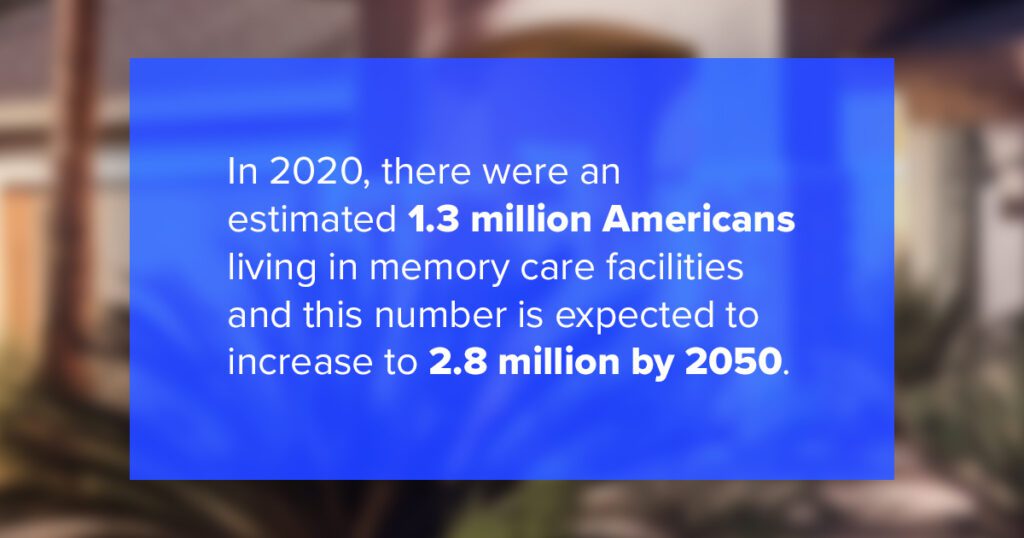
The cost of memory care can be high, with average annual costs ranging from $36,000 to $150,000. Medicare and Medicaid do not cover the full cost of memory care, so many families must pay for it out of pocket.
It is where many entrepreneurs see an opportunity to not only meet the growing demand in the market but to do a lot of good in the process. The profitability of memory care homes is significant and a niche that many savvy investors are expanding into.
The options for memory care for seniors include residential memory care facilities, nursing homes, and in-home care. In each of these options, seniors are provided 24-hour care and supervision. Safety and security features are added to accommodations to ensure that residents can’t wander or find themselves in troubling situations. Generally, the staff for these facilities has been trained to handle the specific needs and challenges that seniors with memory care issues might face. The best option for memory care will vary depending on the individual’s needs and preferences.
Memory care is rapidly growing in the RAL industry, driven by demand and profitability. Monthly rents for these facilities range from $3,000 to $12,000, depending on the location, accommodations, and services included. The rental income is very appealing, and more investors are seeing the cash flow potential. When an investor gets their RAL business going, the option to expand into memory care isn’t that large of a jump. Essentially, the residents require similar types of care which makes staffing relatively simple. There are some changes in staff training, home security features, and possibly licensing depending on the state. Overall, memory care is a great option for any RAL investor to explore, and we see a significant demand for it over the next few decades.
First Steps to Getting Started In Residential Assisted Living
There are so many elements to consider when starting your RAL business. The main steps can be broken down into hundreds of detailed specifics, which is why we have such a popular and exhaustive training course at the RAL Academy, where we cover everything you need to be successful in this industry. But for the purpose of this article, here is a brief overview of the path to take when beginning to build your RAL business.
Steps to starting a senior care business:
- Do your research. Before you start any business, it’s important to research and understand the industry you’re getting into. In the case of a senior care business, it means understanding the needs of seniors and their families as well as the regulations governing senior care in your area.
- Develop a comprehensive business plan. A business plan is a roadmap for your business. It should include your goals, strategies, financial projections, and many other details we explore in our 3-Day Fast Track course. Here you will find personal time with our experts to go over your individual goals and business plan.
- Obtain the necessary licenses and permits. The requirements for licenses and permits vary from state to state, so it’s important to check with your local authorities to ensure your facility is up to code and procedures are in line with regulations.
- Find a location. The location of your senior care business is important. You’ll need to find real estate with characteristics that are optimal for running a thriving RAL business. At the RAL Academy training course, you will find a more comprehensive checklist of location attributes to help you select the best choice for your business.
- Hire staff. You’ll need to hire staff to provide care for your residents. If you have never run a business like this, there are many unique things to consider when finding the right staff for your team. Our article, Finding Staff for Your Assisted Living Home, is a great place to help you understand the kind of qualities you want your team to have.
- Market your business. Before you’re even up and running, you’ll need to market your business to seniors and their families. In this age of information and social media, many options get your business seen by those in your community. However, there are tried and true methods, like traditional advertising, networking, and word-of-mouth.
- Network with other senior care providers. Networking with other senior care providers can be a great way to learn about the industry and get referrals.
- Get involved in the community. Get involved in the community to help you build relationships with seniors and their families. It can also help you raise awareness of your business.
- Provide quality care. The most important thing is to provide quality care to your residents. It means providing them with the physical, emotional, and social support they need.
- Be patient. It takes time to build a successful senior care business. It’s easy to be discouraged if you don’t see results immediately. Work hard and provide quality care, and you’ll eventually be successful.
Starting a senior care business can be a rewarding experience. However, it’s important to remember that it’s also a lot of work. If you’re passionate about helping seniors and willing to put in the hard work, then starting a senior care business could be the right business for you.
Fast-Track Your Residential Assisted Living Business
The bottom line is that there has never been a better time to start your own residential assisted living business. It offers personal investment flexibility, significant and sustained cash flow, and scalable growth potential that could see you creating a financial legacy for your family for years to come. The demand is here, and expert economists have concluded it will grow significantly over the next two decades.
Although RAL businesses are extremely profitable and growing in popularity with investors, the knowledge, expertise, and resources needed to begin can take a while to uncover on your own. Why learn how to start a senior housing business on your own through trial and error when you can get guidance from the nation’s leader in RAL business training? Explore the RAL Academy’s 3-Day Fast Track training program that can get you started and save you from wasting precious time and tens of thousands of dollars on costly mistakes.
Our professional instructors are the best at what they do because they have years of personal experience investing in, building, and running senior living businesses. There’s nothing like getting the expertise of someone who has already been where you want to be. And take it from our students and success stories, the RAL industry is where you want to be.
In addition to our popular 3-day training program, we have several other options to help you get started in this amazing industry at your own pace. Check out our Home Study Course and learn everything you need to know about building a profitable RAL business on your own time from the comfort of your own home.
And if you are still curious about whether this is the right investment opportunity, check out our FREE Intro Course. It will help you get a better overall understanding of the business of assisted living.
The demand for Residential Assisted Living is here, and it’s only getting bigger. Markets throughout the country are ripe for investment. Are you ready to get started?
Ask yourself the following questions:
- Are you ready to get out of the grind and start creating significant cash flow?
- Do you want to build a legacy for your family and set them up financially?
- Are you tired of working for someone else? Do you want the freedom to choose how and when you work on your terms?
- Do you want to make a difference in the lives of others?
- Are you ready to contribute to an industry that changes communities for the better?
- Are you ready to take on the most rewarding work you’ll ever do?
If you answer “yes” to any of these questions, the Residential Assisted Living Academy can help you get started; we’ll walk beside you. Get ready for the ride of your life.

